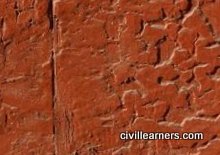Terra-cotta | Manufacturing | Types | Uses – civillearners
Definition Terra-cotta:
Terra means earth and cotta means baked. Hence terra-cotta means baked earth. It is thus a type of earthenware. Further we will see Manufacturing, Types, Uses, Advantages of terra-cotta
Manufacture of terra-cotta:
Following four distinct operations are involved in the manufacture of terra-cotta:
1) Preparation of clay
2) Moulding
3) Drying
4) Burning.
Each operation will now be briefly described.
1) Preparation of clay :
For terra-cotta, se]ected clay is taken. The clay should contain a slightly higher percentage of iron oxide, about 5 to 8 per cent and the proportion of lime should be less, about 1 per cent or so. Sometimes, several varieties of clay with high alumina content are taken and then, to this mixture is added sand, ground glass, old terra-cotta or pottery.
Addition of such materials gives strength and rigidity to terra-cotta products and it prevents shrinking while drying. Such clay is made free from any impurity such as grit, pebbles, organic matter, etc. It is then finely crushed and pulverised. Water is added in the required quantity and the ingredients are thoroughly mixed with spades. Such wet clay is kept for several days in a damp condition for weathering and tempering. It is then pressed or kneaded in a pug mill and it is made ready fr.ff the next operation of moulding.
The required quantity of colouring substance is added at this stage to obtain the desired shade of colour in the final product of terra-cotta.
2) Moulding:
Clay is placed in moulds which represent the pattern or shape in which the product is to be formed. For terra cotta work, moulds of plaster of Paris or templates of zinc are used. Size of moulds is determined by keeping due allowance for shrinkage. Fine sand is sprinkled on the inside surface of moulds and clay is then pressed in moulds with hand.
3) Drying:
Moulds filled m with clay arc kept for some days for drying. After this period, articles of terra-cotta are taken out from moulds and they are allowed to dry further in a room or under a shed. Drying process of terra cotta should be done slowly with proper temperature control.
4) Burning:
Dried products arc then burnt in special muffle furnaces. Fig. 2-2 shows a typical muffle furnace. A muffle indicates a box or a compartment of a furnace in which things can be heated without contact with the fuel and its products.
A damper indicates a metal plate which is provided in an opening to regulate the draught. Dried articles are arranged in muffle and the temperature of the kiln is raised to about 1200°C. This temperature is maintained for about four days and the burnt products are then allowed to cool down in kiln for a period of about five days. For getting the glazed products, glazed materials should be applied by brush on terra-cotta products before they are burnt.
Also read: Different types of tiles
Varieties:
Terra-cotta articles are of the following two types:
1) Porous terra-cotta
2) Polished terra-cotta.
1) Porous terra-cotta:
To prepare porous terra-cotta, sawdust or ground cork is added in clay before the stage of moulding. When particles from such clay are burnt in a kiln, organic particles are burnt and they leave pores in the particles. Porous terra-cotta is a fireproof and soundproof material. It can be sawn and nailed easily with nails, screws, etc. It is light in weight, but it is structurally weak.
2) Polished terra-cotta:
This is also known as fine terra-cotta or faience. To obtain this variety of terra-cotta, articles are burnt at a lower temperature of about 650°C. First burning is known as biscuiting. Articles brought to the biscuit stage are removed from the kiln and are allowed to cool down. They are coated with a glazing compound and burnt again in the kiln at a temperature of about 1200°C. Faience is available in
a variety of colours and it indicates the superior quality of terra-cotta.
Advantages:
1) It is a strong and durable material.
2) It is available in different colours.
3) It is cheaper than ordinary finely dressed stones.
4) It is easily cleaned.
5) It is easily moulded in desired shapes.
6) It is fireproof and can, therefore, be conveniently used with R.C.C. work.
7) It is light in weight.
8) It is not affected by atmospheric agencies and acids.
Disadvantages:
1) It cannot be fixed during the progress of work. But it is to be fixed when the work is in the final stage of completion.
2) It is twisted due to unequal shrinkage in drying and burning.
Uses of terra-cotta:
1) Hollow terra-cotta blocks are used for various ornamental purposes such as facing work, arches, cornices, casing for columns, etc.
2) It is adopted for ornamental work.
3) It is used as a decorative material in place of stones.
A short note on earthenware
Earthenware:
The term earthenware is used to indicate articles prepared from clay which is burnt at a low temp and cooling down slowly. Clay is mixed with the required quantity of sand, crushed pottery, etc.
The addition of such materials prevents shrinkage during drying and burning. Earthenwares are generally soft and porous. When glazed, earthen-, wares become impervious to water and they are not affected by acids or atmospheric agencies. Terra-cotta is a kind of earthenware.
Conclusion:
I hope that my friends have completely understood Terra cotta If liked the post plz share to your loving friends, Thank u. “Sharing is Caring” For more info Read😊😊
Do follow us on all social media platforms for Knowledge and Subscribe to our Website and Turn on the notification bell for knowledge more


